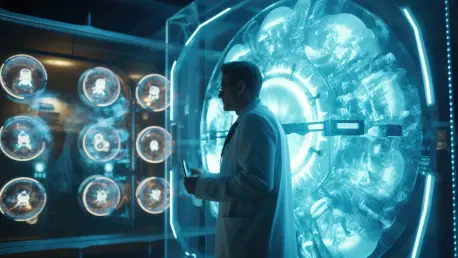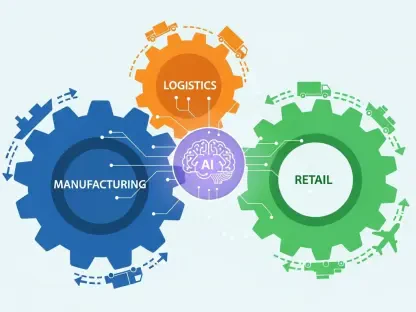Imagine a world where a life-threatening condition like a stroke is detected within minutes of a scan, not hours, thanks to the seamless integration of artificial intelligence in medical imaging. This isn’t a distant dream but a reality being shaped by a pioneering team at the University of Miami Miller School of Medicine, under the leadership of Dr. Jean Jose. Their innovative framework is transforming radiology by embedding cutting-edge AI tools into clinical workflows, promising not only enhanced diagnostic accuracy but also a renewed focus on patient trust and ethical responsibility. This isn’t just about adopting new technology; it’s about redefining how healthcare professionals save lives while addressing the mounting pressures of an overburdened system. The approach balances automation with human oversight, ensuring that technology serves as a powerful ally rather than a replacement for skilled expertise.
The Power of AI in Radiology
Enhancing Diagnostics and Efficiency
The integration of AI into radiology marks a significant leap forward in how medical imaging is conducted, with automation at the heart of this transformation. AI tools are now capable of triaging imaging studies, prioritizing urgent cases, and identifying critical conditions like strokes or pulmonary embolisms with remarkable speed and precision. This capability ensures that life-saving interventions can be initiated much sooner than traditional methods would allow, directly impacting patient survival rates. Beyond speed, the accuracy of AI-driven diagnostics reduces the likelihood of missed diagnoses, offering a layer of reliability that supports radiologists in high-pressure environments. The result is a streamlined workflow that not only enhances patient care but also optimizes the use of limited resources in busy medical facilities.
Moreover, the efficiency brought by AI extends to handling large volumes of imaging data, a task that often overwhelms even the most experienced professionals. By automating routine analyses, such as identifying patterns in X-rays or MRIs, these tools allow for quicker turnaround times on results without sacrificing quality. This is particularly vital in emergency settings where every second counts, and delays can have dire consequences. Additionally, AI’s ability to flag subtle abnormalities that might escape the human eye adds a critical safety net, ensuring that no detail is overlooked. As a result, healthcare systems can manage higher caseloads while maintaining, or even improving, the standard of care delivered to each patient.
Reducing Radiologist Burnout
One of the less discussed but equally significant benefits of AI in radiology is its role in alleviating the intense workload faced by radiologists. By taking over repetitive and time-consuming tasks such as preliminary image sorting or basic anomaly detection, AI enables these professionals to focus on more complex cases that require nuanced interpretation and decision-making. This shift not only improves the quality of diagnostic work but also helps combat burnout, a pervasive issue in the field driven by long hours and relentless demand. Reducing stress and fatigue among radiologists ultimately translates to better patient care, as rested and focused clinicians are more likely to make accurate assessments.
Furthermore, the psychological relief provided by AI support cannot be understated in an era where healthcare workers face unprecedented challenges. Knowing that routine tasks are handled efficiently by technology allows radiologists to dedicate their mental energy to patient interaction and interdisciplinary collaboration, fostering a more holistic approach to medicine. This reallocation of focus also opens opportunities for continuous learning and skill enhancement, as professionals can engage more deeply with evolving medical knowledge rather than being bogged down by repetitive duties. In essence, AI acts as a partner that lightens the load, preserving the human element in radiology while enhancing job satisfaction across the board.
Ethical and Regulatory Challenges
Prioritizing Human Oversight and Trust
Despite the impressive capabilities of AI in radiology, the importance of human judgment remains paramount in ensuring safe and effective patient care. The framework developed by the University of Miami team places a strong emphasis on structured protocols that maintain rigorous human oversight over AI-generated findings. This approach safeguards the quality of care by ensuring that technology serves as a supportive tool rather than an autonomous decision-maker, preventing potential errors that could arise from over-reliance on algorithms. It also upholds ethical standards by integrating checks and balances that keep patient well-being at the forefront of every diagnostic process, reinforcing the principle that machines must complement, not replace, clinical expertise.
Transparency with patients forms another critical pillar of this ethical framework, particularly when it comes to the use of AI tools that have not yet received FDA clearance. By prioritizing informed consent, the team ensures that individuals are fully aware of how AI contributes to their diagnosis and treatment plans, fostering a sense of trust in the technology. This open communication helps demystify the role of AI, addressing any concerns or misconceptions patients might have about automated systems influencing their care. Such efforts are essential in building confidence in medical innovations, ensuring that technological advancements are embraced as allies in health rather than sources of uncertainty or fear among those receiving treatment.
Navigating Regulatory Gaps
The absence of national governance for AI in medicine presents a significant challenge to its safe and consistent deployment across healthcare settings. In response, the University of Miami team has taken a proactive stance by developing institution-specific guidelines that address these regulatory gaps with precision and foresight. These guidelines account for the variability in AI performance that can occur due to differences in equipment, patient demographics, and clinical environments, ensuring that algorithms are locally validated before use. This tailored approach minimizes risks associated with inconsistent outcomes, providing a robust foundation for integrating AI into diverse medical contexts without compromising safety or efficacy.
Additionally, the creation of these bespoke protocols reflects a broader commitment to ethical responsibility in the face of evolving technological landscapes. By establishing clear definitions and operational standards, the framework mitigates potential legal and ethical pitfalls that could arise from unregulated AI use, such as misdiagnosis or breaches of patient privacy. This forward-thinking strategy also sets a precedent for other institutions to follow, offering a model for how to navigate uncharted regulatory territory with caution and diligence. As AI continues to reshape radiology, such efforts are crucial in ensuring that innovation aligns with the core mission of healthcare: to protect and prioritize patient well-being above all else.
Operational and Financial Viability
Building a Sustainable Model
Implementing AI in radiology requires more than just cutting-edge software; it demands a comprehensive operational strategy to ensure long-term success. The University of Miami framework was rigorously tested through pilot projects approved by the Institutional Review Board, evaluating not only the technology itself but also the supporting infrastructure and staff readiness. Investments in specialized training for radiologists and technicians, alongside robust IT systems to handle AI integration, have proven essential in making this model practical for real-world application. These efforts ensure that the system is not merely a technological novelty but a reliable component of daily clinical workflows, capable of adapting to the dynamic needs of healthcare environments.
Beyond operational readiness, the scalability of this framework adds to its appeal as a sustainable solution for modern medicine. The phased implementation allowed for real-time feedback and adjustments, addressing challenges such as system integration or user adaptation before they could derail progress. This methodical approach demonstrates that AI can be embedded into existing structures without causing disruption, provided there is sufficient planning and support. As a result, healthcare facilities adopting this model can expect a smoother transition to AI-enhanced radiology, minimizing downtime and ensuring continuity of care while embracing innovation.
Financial Returns on Ethical Innovation
A key strength of the University of Miami framework lies in its financial viability, proving that ethical innovation can also be cost-effective. A theoretical business model developed alongside the framework projects significant annual revenue increases, driven by improved detection rates and enhanced follow-up care for conditions like missed coronary interventions. These gains offset the initial investments in training, infrastructure, and technology, illustrating that responsible AI integration can yield tangible economic benefits without compromising patient care. This balance of ethics and profitability makes the model an attractive option for healthcare systems seeking to modernize while maintaining fiscal responsibility.
Moreover, the financial returns extend beyond direct revenue to include indirect savings from improved patient outcomes, such as reduced hospital stays and lower mortality rates. By enabling earlier interventions and more precise diagnoses, the framework minimizes the need for costly emergency treatments or prolonged care, easing the economic burden on both providers and patients. This dual impact—enhancing care while bolstering the bottom line—underscores the potential of AI to transform radiology into a more efficient and sustainable field. As more facilities consider adopting similar approaches, these financial insights provide a compelling case for investing in technology that prioritizes both human and economic health.
Patient-Centered Impact
Improving Outcomes and Care
The most profound impact of the AI framework in radiology is evident in the measurable improvements to patient outcomes, a testament to its patient-centered design. Through rapid response systems like Point-of-Care AI Deployment (POCAID), critical findings such as intracranial hemorrhages are flagged and acted upon within minutes of a scan, significantly reducing mortality rates. This immediacy, supported by coordinated efforts among nurses, clinical coordinators, and radiologists, also shortens hospital stays by ensuring swift interventions. Such advancements highlight how AI can bridge the gap between detection and treatment, delivering life-saving care when it matters most and setting a new benchmark for emergency medical response.
Equally important is the framework’s ability to enhance care beyond urgent scenarios, addressing the full spectrum of patient needs with precision. By integrating AI tools into routine imaging processes, subtle but significant issues that might otherwise go unnoticed are identified early, allowing for timely management. This comprehensive approach ensures that patients receive not only reactive treatment for emergencies but also proactive care that prevents future complications. The result is a healthcare model that prioritizes longevity and quality of life, demonstrating that technology, when guided by responsibility, can profoundly elevate the standard of medical practice.
Proactive Management for Holistic Health
The framework’s focus on non-critical findings further underscores its commitment to holistic patient care, extending benefits beyond immediate crises. For instance, incidental coronary artery calcification detected during routine scans is systematically flagged for follow-up, enabling preventive measures that can avert serious cardiac events down the line. This proactive strategy ensures that patients are not merely treated for what is urgent but are supported in maintaining long-term health through informed and timely interventions. Such attention to detail transforms radiology from a reactive field into a cornerstone of preventive medicine, empowering patients with knowledge and care options.
Additionally, this emphasis on follow-up care fosters a deeper connection between healthcare providers and patients, reinforcing trust through consistent engagement. By addressing incidental findings with the same rigor as critical ones, the framework ensures that no aspect of a patient’s health is overlooked, regardless of immediacy. This comprehensive care model also alleviates the burden on emergency systems by reducing the likelihood of preventable conditions escalating into crises. As a scalable solution, it offers a glimpse into a future where radiology plays a pivotal role in not just diagnosing but also safeguarding overall well-being through sustained, thoughtful care.
Scalability and Future Potential
Expanding Reach Across Healthcare Systems
The scalability of the AI framework developed at the University of Miami stands as one of its most promising attributes, pointing toward a broader transformation in healthcare. Already, this model is being expanded to other facilities within the UHealth—University of Miami Health System, including high-profile centers like Sylvester Comprehensive Cancer Center and UHealth Doral. This growth demonstrates the framework’s adaptability to diverse clinical settings, from specialized oncology units to general care facilities, without losing its core focus on safety and efficacy. Such expansion signals a potential shift in how radiology is practiced on a larger scale, offering a blueprint for other institutions to integrate AI responsibly.
Furthermore, the successful rollout to multiple facilities highlights the framework’s capacity to address varying operational challenges, such as differing patient volumes or technological infrastructures. This flexibility ensures that the benefits of AI-enhanced radiology—improved diagnostics, reduced burnout, and better outcomes—can reach a wider population, regardless of geographic or institutional barriers. As more healthcare systems take note, the framework’s influence could redefine industry standards, encouraging a unified approach to innovation that prioritizes both technological advancement and patient-centered care across the board.
Shaping the Next Era of Medical Imaging
Looking ahead, the framework’s early successes pave the way for even greater advancements in medical imaging during its initial implementation. The collaborative spirit behind its development, uniting radiologists, IT specialists, and ethicists, establishes a model for balancing innovation with caution that continues to inspire. Reflecting on these efforts, it’s clear that the groundwork laid by this team creates a ripple effect, encouraging ongoing dialogue about how to refine AI tools for diverse medical challenges. The emphasis on ethical deployment and human oversight becomes a guiding light for future projects, ensuring technology remains a servant to humanity’s needs.
Moving forward, stakeholders in healthcare should consider adopting similar structured approaches to harness AI’s potential while mitigating risks, building on the lessons learned from this initiative. Exploring partnerships between academic institutions, technology developers, and regulatory bodies could accelerate the creation of universal guidelines that were once absent. Additionally, investing in continuous training for medical professionals will be crucial to keep pace with evolving AI capabilities. These steps, inspired by past achievements, promise to shape a future where radiology not only heals but also anticipates, ensuring every patient benefits from the safest, smartest care possible.









